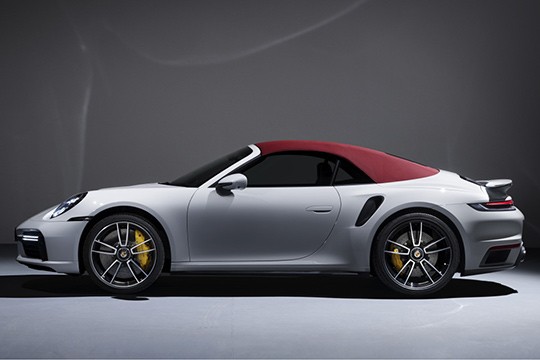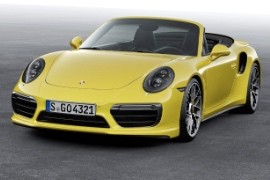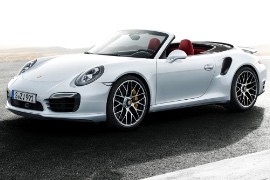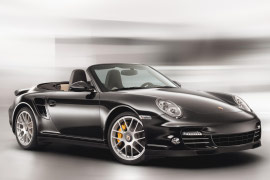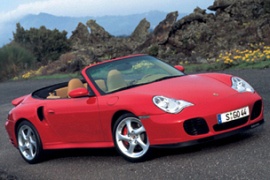PORSCHE 911 Turbo S Cabriolet Models/Series Timeline, Specifications & Photos
First production year: 2004
Engines: Gasoline
Body style: Convertible (spider/spyder, cabrio/cabriolet, drop/open/soft top)
The Turbo S Cabriolet was the choice for those who wanted an incredible fast super-car able to be driven slow, as a daily-driver, with the top down.
The history of internal combustion engines was not over when the Porsche 911 Turbo S was introduced to the market. And it wasn't just about the power and the way it handled it. It also was about driving under the clear sky.
The front side of the Turbo S and Turbo S Cabriolet featured a lip on the front bumper that was extended when needed to reduce the aerodynamic lift. The three big air-intakes looked like there was a trade between the engine department and the brakes department who will get more room for cooling. The car featured 20” front wheels and 21” rear wheels. Behind the rear seats, there was the storage area for the soft-top. A big panel will go back and the roof will disappear underneath. With the roof up, the sleek form of the classic 911 shape was kept.
Inside, the Turbo S featured a completely new dashboard. The tachometer was the only analog gauge in the instrument cluster. It was complemented on its sides by two other TFT displays. In the dashboard, at the same level as the three-spoke aluminum steering wheel, there was the screen for the PCM (Porsche Communication Management) infotainment unit. The 911 Turbo S was fitted as standard with 18-way power-adjustable seats in the front and two tiny folding seats in the back.
The engineering part of the car was the biggest improvement. It offered a newly developed, direct-injected 3.75-liter engine. It was fed by a pair of VTG turbochargers (variable turbocharged geometry) with a total result of 650 hp (70 hp more than its predecessor). It was paired to a standard 8-speed PDK (dual-clutch) automatic transmission.
In 2016, the 991 generation of the Porsche 911 received a mid-life cycle refresh and it was introduced to the market. The Porsche Turbo S Cabriolet was enhanced as well.
Ever since 1974, the introduction of a Porsche Turbo was a hot moment for Porsche enthusiasts. With the convertible versions, the famous supercar became more appealing for those who were looking for a daily-driver supercar. Moreover, since the 911 Turbo proved to be a great all-weather car, due to its all-wheel-drive system.
The facelifted version of the 991 was named 991.2. The car's front end was redesigned with side air blades and narrow LED lights, with double fillets to emphasize the car's width, as the additional fin in the main air intake. The Turbo S Cabriolet featured 7-spoke 20” light-alloy wheels with center lug-nut as standard. The door handles without recess covers gave the car a sleeker look. In the back, the Turbo S was easily distinguished by the four stainless steel exhaust tips in black chrome. To cover or uncover the car, the power-roof needed just 20 seconds. It operated at speeds up to 50 kph (31 mph).
Inside, the new Porsche Communication Management (PCM) with navigation system was fitted as standard. The system featured a 7” touch-screen on the center stack. Unlike its predecessors, the new PCM featured Google Maps with real-time traffic information and Google StreetView. The 555 Wats Bose sound system with 12 speakers was fitted as standard, and a more sophisticated Burmester 821 watt was available on the options list.
For the engine bay, the Porsche Turbo S 991.2 offered 20 hp more than its non-facelifted version, reaching 580 hp. It was mated to a standard 7-speed automatic (dual-clutch) gearbox. To make the car faster and safer, the active roll stabilization program and the carbo-ceramic brakes were fitted as standard.
For those who were not fully satisfied with the performances of the 911 Turbo Cabriolet, Porsche offered the Turbo S Cabriolet, which featured more amenities and some extra horses.
As usual, every 911 generation starts with the Carrera models and the Turbo version comes later. It was always the same marketing strategy and it worked well for Porsche. The Turbo S made its way up to the public in 2014, together with its convertible sibling.
In 1974, the first Turbo made it to the market, but it wasn't until 1988 when the first generation of the Turbo Cabriolet was unveiled. It was a great balance between sport and luxury. The Turbo S version was the same fine GT, but with a sportier character. In the rear, the wide fenders were even larger than those found on the Carrera 4 version by 28 mm (1.1”). The four squared exhausts were made out of stainless steel with black-chromed tips.
Inside, the front Adaptive sports seats with power 18-way adjustments were fitted as standard. They featured a memory package with electric steering column adjustments. The sport steering wheel was fitted with paddle shifters for the standard 7-speed automatic PDK (dual-clutch) gearbox. In the five-dials instrument cluster, the right one was a 4.6” high-resolution color display. The PCM (Porsche Communication Management) audio featured a twelve speaker Bose Surround System, including a 100 W active subwoofer. The power-operated soft-top needed just 13 seconds to open or cover the car, at speeds up to 50 kph (31 mph).
The drivetrain for the Turbo offered a 560 hp flat-six engine with direct fuel injection. It was aided by a pair of turbochargers with variable geometry. For better speed cornering, the car was fitted as standard with PASM (Porsche Active Suspension Management) and all-wheel steering.
The Cabriolet was built to offer the thrills and the look of a 911 Turbo version, but with a top that could be dropped for a pleasant, relaxed drive.
For the 2010 model, the car featured large air intakes and bar-shaped LED turn-signals. In the side-scoops air intakes needed to cool the front brakes, the designer incorporated the daytime running lights with LED, instead of the usual foglights. The headlights featured optional dynamic lights that improved illumination on the bends due to a swiveling mechanism. On the upper side of the rear fenders, a twin air-intake was placed to help to cool and feed the engine with fresh air. The wing on the engine hood made an important aesthetic difference between the Turbo and the rest of the 911 models.
The interior was fitted as standard with a three-spoke steering wheel and aluminum paddle-shifters behind, to manually control the gears. The sport-bucket seats were fitted as standard. For the infotainment unit, Porsche installed the PCM (Porsche Communication Management), with iOS compatibility. For Android users, the car-manufacturer offered a special application. The power-roof could open or close the top in 20 seconds at speeds up to 50 kph (31 mph).
The first Porsche 911 Turbo Cabriolet appeared in 1975 and offered a 260 hp from a flat-six 3.0-liter engine. The 2010 Turbo S Cabriolet featured a new engine management system that allowed a more aggressive of the intake valves and a bigger boost for the turbochargers from 1 bar (14.5 psi) to 1.2 bars (17.4 psi). The result was an increase in power by 30 hp over the regular 2010 Porsche Turbo. The direct-injected 3.8-liter engine was mated as standard to a 7-speed PDK (double-clutch) automatic gearbox.
In 2000, Porsche introduced its first Turbo Cabriolet version since the 964 generation from 1989. Four years later, due to high demands, it added the Turbo S to the open-top body version.
It was faster and more comfortable than most of the GT vehicles on the market and it proved that you don't need a fixed roof to enjoy a fast drive. Moreover, it allowed driving with the roof down at warp speeds.
From the outside, the front bumper attracted views due to its large three air-intakes needed to cool the radiators. On its sides, another pair of air-intakes needed to feed the big turbochargers were installed in front of the rear wheels. The retractable roof was able to be stowed away in 20 seconds at speeds of up to 50 kph (31 mph), like the rest of the 911 convertible range. With the roof up, the car was tested in the wind tunnel at speeds of up to 338 kph (210 mph). And it had the engine to push almost that hard.
Inside, the Turbo S Cabriolet shared most of its parts with the Turbo Cabriolet, with some small changes to the instrument cluster and gear-stick. The dials featured an aluminum background instead of black ones, and on the gear-stick, the aluminum badge featured the “Turbo S” letters instead of just “Turbo”.
The 450 hp, 3.6-liter twin-turbo engine was placed in the back, as in any Porsche 911. The all-wheel-drive system was standard and that diminished the luggage compartment and the fuel tank in the front. There was a choice of two transmissions: a 6-speed manual and a 5-speed automatic gearbox (Tiptronic) with manual override to change gears, and paddle shifters.
